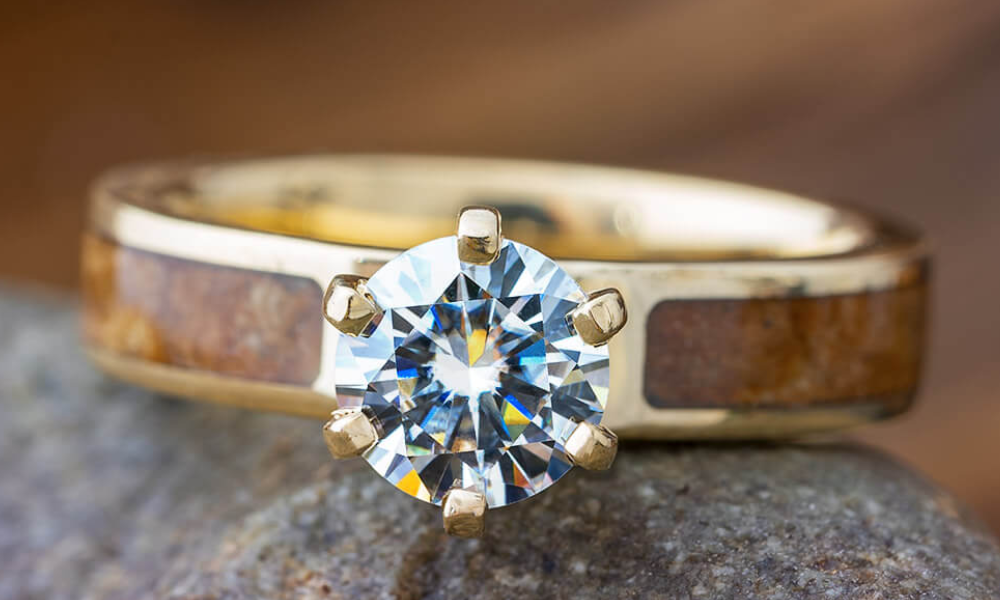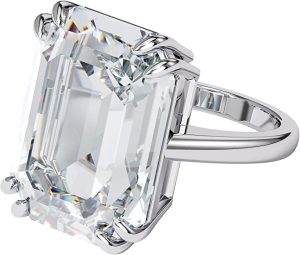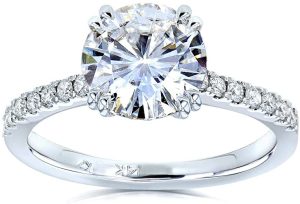There are numerous factors to consider when purchasing a diamond or a Swarovski ring. If you’re thinking about purchasing a diamond for your engagement ring, it’s essential to understand the differences between the two materials. Continue reading to learn more about these distinctions and the advantages and disadvantages of each type of stone. In addition, don’t forget to check out our diamond buying guide to find the ideal diamond ring for your special occasion.
The first difference is that Swarovski crystals are cut by a machine, whereas diamonds are cut by hand by a highly skilled jeweler. Even though these stones have a similar appearance, they are cut with greater precision. Diamonds are never cut in the same way twice, and different companies use different grading scales to distinguish between them. Generally speaking, a good diamond is round and flawless, but that’s about all there is to it. Swarovski crystals have a shorter life span and lower quality than diamonds, even though they are significantly more expensive.

Swarovski vs. Diamond
Do you work in the jewelry industry and have questions about Swarovski and diamonds? Even though Swarovski is a good copycat crystal for diamonds, is it better than a diamond itself? Every detail you require will be covered in this article, so read on!
After conducting extensive research, we discovered that people unfamiliar with jewels and gemstones frequently make the mistake of confusing Swarovski crystal with diamond. As a result, we believe it is critical to address the issue. Are you ready to learn more about the differences between Swarovski and diamonds? Let’s get started!
Swarovski
Swarovski Crystal is a glass made by melting silicon oxide powders with lead to form a lead crystal. Swarovski has patented the exact process, but it contains approximately 32% lead to increase the crystal’s refraction index to that of a diamond. The crystal glass is precision cut and then polished using a Swarovski patented process to create a diamond effect. The Aurora Borealis (AB) coating gives the surface a rainbow-like appearance, simulating dispersion from a diamond. Swarovski crystal has a Mohs hardness of 6-7, making it more susceptible to scratches and chipping than regular glass. A higher refraction index of glass (1.7) is achieved by adding lead to the crystal.
Whatever gem or crystal you choose for your jewelry designs, you can be sure that they will sparkle beautifully. Most will choose based on price. Swarovski is unquestionably the cheapest diamond substitute. As a symbol of quality and elegance, it is used by many of the world’s top fashion houses in both their designs and to promote their brands. On the other hand, Cubic Zirconia lacks the Swarovski brand name but is a more durable diamond substitute. A CZ range from Swarovski is worth investigating as you get the brand and a high-quality gemstone without the stigma of a CZ fake diamond. As more cultured diamonds become available, the price of genuine diamonds is likely to fall. Maybe people will accept a synthetic version in its place because appearance, not history, is essential when looking for an engagement ring.
Diamond
Diamond is the most valuable precious gemstone due to its intrinsic beauty. Diamonds are rare and therefore expensive anywhere in the world. It is said that diamonds are so rare that people make up stories about how they are formed.
Some say coal gave birth to diamonds. This is not true. It is believed that most, if not all, of the world’s diamonds, come from the mantle and are brought to the surface by volcanic activity. Diamonds are also believed to be delivered via kimberlite and lamproite pipes in the Earth’s mantle.
Diamond prospectors are always looking for natural geological vents to explore for diamonds. Real diamonds require the harshest conditions in the Earth’s mantle. Diamonds are thought to form in “stable zones” 90 miles below the Earth’s surface, at temperatures around 2000°F.
Due to the unique requirements for diamond formation, diamond mining and production are limited to a few major countries. Blue diamonds have been discovered in trenches 400 miles deep in the Earth’s mantle, and blue diamonds likely formed with the oceanic crust.
Color
Swarovski crystals are available in a staggering 84 different colors, and Swarvoski crystals are available in every color of gemstone available on the planet. When purchasing Swarovski crystals online, you can also consult color charts to see what shades are currently available.
On the other hand, Diamonds are frequently colorless, and their value is increased as a result of their colorlessness. Colorless diamonds are available in various shades ranging from a light tint to complete colorlessness. Colored diamonds are also available, and depending on how many carats are in the diamond in the first place; they can fetch millions of dollars. The presence of color in diamonds is also sporadic, with colored diamonds accounting for less than 1% of all diamonds mined around the world.
Cut
The cut of gemstones is one of the most important aspects to consider, mainly if you invest in jewelry.
It is based on scientific principles developed by the Gemological Institute of America for grading diamonds that Swarovski has developed its unique X-Cut technology. Premium cuts characterized by the interplay of multi-layered surfaces and angles are made possible by advanced optical measurement and high-precision manufacturing. The XILION and XIRIUS models serve as the most prominent examples. The “science of geometry” is responsible for raising the crystals’ brightness, fire, and scintillation to an unprecedented level of brilliance.
However, diamonds are not always as brilliant as Swarovski crystals, and this is because not all diamond manufacturers are created equal. It is impossible to distinguish between freshly minded diamonds and fancy diamonds found at auctions and jewelry stores. Before diamonds can be made to sparkle like magic, they must first be cut, drilled, and polished.
The cut of a diamond is divided into five categories: poor, fair, good, very good, excellent, and ideal, with the ideal at the top of the list. Ideal diamonds are frequently cut into round diamonds due to their excellent symmetry. The diamond’s brilliance reflects most of the light entering a diamond, and diamonds in poor and fair condition reflect very little light. When it comes to diamonds, the scale of the cut impacts their value, but even the worst-cut diamonds will retain their high value compared to other types of gemstones.
Clarity
Swarovski crystals are known for their exceptional clarity. Because the materials are softer than diamonds, it is easier for machines to create Swarovski crystals that are as clear as the sky, as opposed to diamonds. On the other hand, Diamonds are unique in the way they allow light to enter and reflect. When it comes to diamonds, a particular scale is used to determine their clarity.
The scale starts with included, progresses to slightly included, very slightly included, very slightly included, internally flawless, and finally flawless. Included is the first position on the scale. The flawlessness of a diamond is influenced by various factors, including the manufacturer’s guidelines and how the diamond was processed after it was harvested. Internally, flawless diamonds will exhibit pure structures even when magnified ten times more than their surface appearance.
Diamond buyers and collectors are well-known for being extremely picky about their purchases. They will go to any length to detect even the most minor flaws in the diamonds they consider buying. When a diamond is described as “eye clean,” it means that you will not be able to detect any internal blemishes in the diamond by simply looking at it. You don’t need to look for diamonds that are “flawless” or “internally flawless” unless you’re a high-end diamond collector, and even then, you shouldn’t bother.
Price
Swarovski crystals can sell for as much as $125 per specimen, while diamonds can sell for as much as $1000 per piece of jewelry at the very least. Considering that, Swarovski crystals are already on the expensive side at $125 per crystal. Can find similar-looking products with the same type of crystal for as little as $49 or less if the item is on sale. Swarovski crystals are an affordable luxury jewelry option that will not break the bank if you are looking for affordable luxury jewelry. On the other hand, if you require something that will last a lifetime, such as a wedding ring or an engagement ring, you may want to consider investing in diamond jewelry instead.
Sparkle
It will be easy for you to choose between the two jewels of how much they sparkle. When Swarovski crystals were first manufactured, they shone brighter than any other crystal. Daniel began using an electric machine to enhance the beauty of this feature, which resulted in a significant improvement.
When it comes to diamonds, you will notice that they have a beautiful sparkle. In contrast to Swarovski crystals, not all diamonds have the same level of sparkle because the cut determines how they will sparkle and sparkle. Diamonds with a good cut have more sparkle than other types of diamonds.
In general, we can say that diamonds and Swarovski crystals both sparkle more brightly than other gems than other types of gemstones. As a result, the two are somewhat similar. This factor is the first to demonstrate that Daniel did a fantastic job of bringing the sparkle to Swarovski crystal. The company ensures that the jewel has a good sparkle by employing the electric machine he invented.
Brilliance
Another essential factor to consider is one’s level of brilliance. When comparing diamond and Swarovski, diamond has a higher level of brilliance. Due to their ability to refract light, they have this property. As a result, the one with a high refractive index shines brighter than the other.
Diamond has a higher index of 2.42 than the other gemstones. Diamonds’ brilliance is determined by how they are cut, just as their sparkling ability is. The more light that escapes through the gemstone at its back, the less glow it emits in comparison.
Swarovski crystal has an index of 1.7, which is very high. It demonstrates that the brightness and contrast of the material are not as good as those of diamonds.
Hardness
It is reasonable to assume that diamond is more complex than Swarovski in this instance. According to the Mohs scale of hardness, the hardness of a jewel is determined by how well it can withstand a scratch. The levels are numbered one through ten.
Diamond receives the highest rating, which is a 10. Because its ability to withstand scratches demonstrates that it will not fade quickly. . You can find this characteristic in every diamond.
Six to seven is the level of Swarovski crystal, and it implies that they are susceptible to becoming scratched and cloudy after a certain period. Every Swarovski jewel is subject to the hardness test.
Is Swarovski’s Luster Comparable to that of a Diamond?
In contrast to Swarovski crystals, not all diamonds have the same level of sparkle because the cut determines how they will sparkle and sparkle. Diamonds with a good cut have more sparkle than other types of diamonds. In general, we can say that diamonds and Swarovski crystals both sparkle more brightly than other gems than other types of gemstones. As a result, the two are somewhat similar.
Is the Money Spent on Swarovski Worth it?
In this particular instance, the answer is no; they aren’t. Swarovski crystals are made of non-precious lead glass, which means that the material’s intrinsic value is not exceptionally high compared to other precious stones. They do, however, have a valuable brand name, which causes their prices to be higher than those of other crystal suppliers.
What is it about Diamonds that Makes them so Expensive?
Due to mines reaching the end of their productive lives, diamond production decreases. There is a limited supply of high-quality gems available, and people worldwide are interested in purchasing diamonds, which is why they are so costly to produce and bring to market. It’s a simple matter of supply and demand.
There is no denying it. Diamonds are pricey, and diamonds are more expensive than gold, platinum, and more. So, why do diamonds cost so much? I’m aware that numerous blog posts claim that it’s all a plot orchestrated by De Beers and jewelers who mark up diamonds by 200 percent, and I’m sorry to break it up. Neither of those statements is correct.
A good quality diamond costs $5000 per carat, which works out to $777,587 per ounce! They aren’t the most expensive substance on the planet (antimatter costs about $500 million per carat), but they are among the top five.
De Beers currently mines less than half of all diamonds and has no control over diamond prices. And today’s retail mark-up on diamonds is usually only 5-10%, not 200 percent. (Have you seen RockHer’s incredible diamond prices? Internet, thank you!)
The diamond conspiracy theorists are quoting a 1982 book by David Jay Epstein, which, like harvest gold refrigerators and leg warmers, may have been slightly exaggerated but is ridiculously out of date 36 years later.
What are Swarovski Crystals, and How do they Work?
It has been a widely held misconception that Swarovski crystals are gemstones for decades. A Swarovski crystal is a piece of glass that has been formed under extremely high temperatures and pressure. Silicon oxide and lead are the chemicals used in the manufacturing process. As a result, it is not a stone but rather a crystal.
Daniel Swarovski was the man behind creating these crystals, which began in 1891. Daniel wished to ensure that people could obtain diamonds without participating in the mining process.
To create them, high temperatures must be used to melt the chemical components together. The ratio that Daniel used in this process has remained a closely guarded secret until this day. The final polishing gives it the appearance of a diamond.
After a thorough polishing, the company applies a protective coating to them known as “Aurora Borealis.” From this vantage point, they appear to be diamonds in every way. Additionally, when exposed to light, this covering takes on the appearance of a rainbow.
Conclusion
Even though diamonds are the most expensive Swarovski crystal, the quality-price ratio of these crystals is excellent. Swarovski crystals are not only less expensive, but they also come in a variety of different styles and designs. Because of its emerald-cut shape, it is a popular choice for engagement rings. Furthermore, they are ideal for everyday use. They have a sophisticated and quirky appearance. A long and distinguished history, as well as excellent customer service, characterize Swarovski.
The transparency and color of a diamond and a Swarovski crystal are two of the most significant differences. Diamonds are colorless by nature, whereas a chemical coating colors Swarovski crystals. Swarovski crystals are available in over 84 different colors, so you won’t have to limit yourself to just one. The possibilities for color combinations with Swarovski crystals are limitless. You can find the color chart on the internet.










